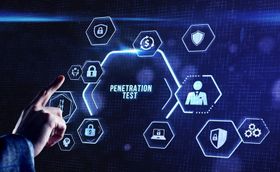Essential Role of vCISO in Cybersecurity: Risk Mitigation & Compliance
Learn how a vCISO helps manage cybersecurity risks and ensures compliance, keeping your organization secure and protected from evolving threats.
Published March 20, 2025.

As businesses face growing cybersecurity risks and increasing regulatory demands, navigating these challenges becomes a top priority. With the rapidly changing threat landscape, it is more important than ever for businesses to implement proactive strategies that protect sensitive data and ensure regulatory adherence.
In this blog, we will explore how a Virtual Chief Information Security Officer (vCISO) can help you strengthen your organization's security framework, mitigate risks, and maintain compliance with industry standards.
» Contact us to strengthen your cybersecurity strategy with expert vCISO services
What Is a vCISO?
A vCISO provides expert guidance on cybersecurity strategy, risk management, and compliance to organizations on a part-time or contract basis.
Key responsibilities include:
Conducting risk assessments and identifying security gaps
Developing and implementing security frameworks
» Read more: What is a virtual CISO?
Unique Benefits of a vCISO
Flexibility: vCISOs can be engaged for specific projects or ongoing support, adapting to changing organizational needs.
Cost-efficiency: They provide high-level expertise at a fraction of the cost of hiring an in-house CISO, making them ideal for small and medium-sized businesses (SMBs).
Scalability: Services can scale with business growth or during high-demand periods like mergers or audits.
Broader expertise: vCISOs bring cross-industry experience and unbiased perspectives, offering innovative solutions tailored to diverse challenges.
Agility: Rapid deployment without traditional hiring delays
» Understand how to engage with a CISO
2 Scenarios Where a vCISO Is Better Than Hiring a Full-Time CISO
1. Startups and SMBs With Budget Constraints
For startups or SMBs with limited budgets, a vCISO provides expert security leadership without the full-time salary and benefits. They gain access to crucial security expertise during early growth phases when resources are tight.
A vCISO helps establish security policies, assess risks, and ensure compliance, allowing businesses to prioritize cybersecurity without the financial burden of a full-time executive.
2. Organizations Facing Temporary Leadership Gaps
When companies undergo transitions—such as mergers, acquisitions, or leadership turnover—a vCISO can quickly step in to provide strategic guidance and maintain continuity in cybersecurity operations. This ensures security programs remain effective, compliance is upheld, and vulnerabilities are managed while the organization searches for a permanent CISO or adjusts its leadership structure.
» Learn more about our virtual CISO services
Key Functions of a vCISO
A vCISO performs both operational and strategic security duties, ensuring a structured approach to cybersecurity.
Strategic Responsibilities
- Security policy formulation and implementation: A vCISO develops security policies that align with business objectives, ensuring a proactive security approach.
- Risk analysis and security roadmap: They conduct thorough risk assessments and create structured security roadmaps to guide long-term cybersecurity planning.
- Regulatory requirements: Ensuring compliance with industry regulations, they help organizations meet legal obligations and avoid penalties.
- Security awareness training: By educating employees, they foster a security-conscious culture and reduce human-related security risks.
Operational Oversight
- Incident response: A vCISO handles security incidents effectively, mitigating risks and minimizing disruptions.
- Vulnerability management and sustaining security controls: They oversee security measures to identify and address weaknesses, ensuring continuous protection.
vCISOs bring value by aligning security with business goals, ensuring good governance and fostering a security-conscious culture. Through professional guidance, organizations can forecast evolving threats, establish a strong security posture, and demonstrate due diligence.
» Understand the disasters you can avoid by tackling cybersecurity on time
Common Cybersecurity Threats and How vCISOs Mitigate Them
Phishing and Social Engineering
Phishing is one of the most prevalent cybersecurity threats, responsible for about 40% of data breaches. Attackers employ deceptive emails, malicious links, and impersonation tactics to trick employees into revealing sensitive information or downloading malware. Industries like finance, healthcare, and IT are especially vulnerable.
Mitigation measures:
- Security awareness training: Regular phishing simulations help educate employees about how to spot social engineering tactics and what to do during an attack.
- Multi-factor authentication (MFA): Adds an extra layer of security to prevent unauthorized access.
- Advanced email filtering: Deploys AI-driven anti-phishing tools to detect and block suspicious emails.
- Incident response protocols: Establishes clear procedures for employees to report phishing attempts.
» Here's everything you need to know about phishing attacks
Ransomware Attacks
Ransomware attacks have surged by over 148% since 2021, with cybercriminals using AI-driven malware and double extortion tactics. Industries such as manufacturing, finance, IT, and healthcare are frequent targets, with attacks occurring at an estimated 4,000 per day.
Mitigation measures:
- Regular offline & immutable backups: Prevents permanent data loss.
- Endpoint detection & response (EDR): Uses behavioral analysis to detect ransomware activity.
- Zero-trust architecture (ZTA): Restricts unauthorized access and limits lateral movement.
- Phishing awareness training: Reduces ransomware entry via email.
» Read more: How to deal with ransomware
Insecure APIs
Around 33% of applications have insecure APIs, making them a prime target for unauthorized access, data breaches, and injection attacks. As API-driven architectures grow, attack surfaces expand, increasing exposure to threats.
Mitigation measures:
- API gateway & rate limiting: Prevents brute-force attacks and abuse.
- OAuth & token-based authentication: Ensures secure access control mechanisms.
- Input validation & encryption: Blocks SQL injection, cross-site scripting (XSS), and man-in-the-middle attacks.
- Continuous API security monitoring: Detects anomalies and potential exploits in real time.
How a vCISO Tailors Risk Mitigation Strategies Across Industries
Healthcare
A vCISO tailors risk mitigation by enforcing strict access controls, encrypting electronic health records (EHRs), and deploying real-time threat monitoring. Regular risk assessments and staff training ensure compliance with regulations and prevent unauthorized access, safeguarding sensitive patient data.
Finance
In the finance sector, a vCISO focuses on combating fraud and regulatory risks. This is achieved through MFA, EDR, secure transaction protocols, and vendor risk management to safeguard against supply chain attacks and ensure regulatory compliance.
Technology
For technology companies, a vCISO emphasizes security by implementing DevSecOps best practices, conducting penetration testing, and monitoring APIs for vulnerabilities. Scalable security frameworks are deployed to protect innovation and assets while adapting to rapid technological advancements.
» Learn more about the different kinds of penetration tests
Tools and Technologies for Ongoing Cybersecurity Monitoring
Security Information and Event Management (SIEM)
- SIEM systems aggregate and analyze logs from various sources, helping a vCISO detect anomalies and potential threats across the network.
- It provides real-time visibility and centralized monitoring for quicker threat identification.
Intrusion Detection/Prevention Systems (IDPS)
- IDPS tools monitor network traffic for malicious activity, identifying potential breaches and preventing attacks.
- It protects against external and internal threats by detecting suspicious activities early.
Endpoint Detection and Response (EDR)
- EDR tools monitor and respond to threats on individual devices, ensuring devices are secure and free from malware or unauthorized access.
- It improves endpoint security by providing real-time threat detection and response.
Vulnerability Scanners
- Continuous assessment of systems and applications helps identify vulnerabilities that may expose the organization to cyberattacks.
- It ensures that all potential weak spots are identified and patched regularly.
Cloud Security Posture Management (CSPM)
- CSPM tools monitor cloud environments to detect misconfigurations and compliance gaps that could lead to data exposure or breaches.
- It protects cloud resources from evolving threats by ensuring security configurations are maintained.
How GRSee Consulting’s vCISO Services Support Compliance and Cybersecurity
With GRSee Consulting’s vCISO services, our expert guidance helps you maintain compliance with essential standards like PCI DSS, ISO 27001, and SOC 2. We perform thorough gap assessments to identify any compliance deficiencies and assist in developing comprehensive policies while preparing you for audits. Our services include continuous monitoring with tools like SIEM, allowing us to track compliance in real-time and manage ongoing cybersecurity risks effectively.
By leveraging our vCISO expertise, you can ensure your business remains secure, compliant, and well-prepared for any audit, all while reducing the risk of penalties.
» Reach out to GRSee and ensure your business stays secure and compliant with our vCISO expertise




